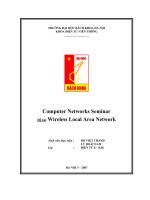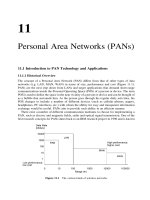Low Rate Wireless Personal Area Networks
Bạn đang xem bản rút gọn của tài liệu. Xem và tải ngay bản đầy đủ của tài liệu tại đây (212.53 KB, 18 trang )
Wireless Communications
Low Rate Wireless Personal Area
Networks
2
Objectives
•
Describe a wireless personal area network (WPAN)
•
List the different WPAN standards and their
applications
•
Explain how IrDA, Bluetooth, and ZigBee work
•
Describe the security features of low-rate WPAN
technology
3
What is a WPAN?
•
Wireless personal area network (WPAN)
–
Group of technologies that are designed for short-
range communications
–
Eliminates the need for wires or cables to interconnect
multiple devices
•
Applications for WPAN technology include:
–
Synchronizing PDAs, cellular, and Smartphones
–
Home control systems (smarthome)
–
Cordless telephones
–
Portable device data exchange
4
What is a WPAN? (continued)
•
Applications for WPAN technology include
(continued):
–
Industrial control systems
–
Location — smart tags used to locate people at home
or at the office
–
Security systems
–
Interactive toys
–
Inventory tracking
•
Advantages
–
WPAN devices use very little power
–
Short range helps maintain security and privacy
5
Infrared WPANs (IrDA)
•
Most common infrared connection today
–
Based on the IrDA specifications
•
IrDA specifications
–
Define both physical devices and network protocols
•
IrDA devices’ characteristics
–
Provide walk-up connectivity
–
Provide a point-to-point method of data transfer
•
Between only two devices at a time
6
Infrared WPANs (IrDA) (continued)
7
Infrared WPANs (IrDA) (continued)
•
Serial Infrared (Version 1.0)
–
Designed to work like the standard serial port on a PC
–
Uses a UART (Universal Asynchronous
Receiver/Transmitter)
•
Microchip that also controls a computer’s serial interface
•
Fast Infrared (FIR) (Version 1.1)
–
Extends the data rate to 4 Mbps
–
When two IrDA devices first communicate
•
They both transmit using SIR
•
Then they shift to FIR speed









